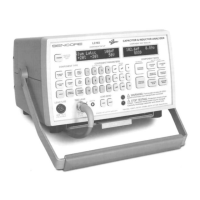51
CAPACITOR FAILURE MODES
An ideal capacitor is defined as “a device consisting of
two electrodes, separated by a dielectric, for introducing
capacitance into an electric circuit”. Unfortunately, we
don't work with ideal components. The capacitors we
encounter every day in our service work are much more
complex than this simple definition. In an actual
capacitor, a certain amount of current leaks through the
dielectric or the insulation. Capacitors have internal
series resistances, can exhibit an effect called dielectric
absorption, and the capacitance can change in value. If
we were to draw a circuit to represent an actual
capacitor, it might look like the circuit in Figure 42.
Fig. 42: Equivalent circuit of a practical capacitor.
The capacitor C1 represents the true capacitance, the
resistance Rp represents the leakage path through the
capacitor, and the resistance Rs, called the Effective
Series Resistance (ESR) represents all of the combined
internal series resistances in the capacitor.
Value Change
Capacitors can change value. On some multi-layer foil
capacitors, poor welding or soldering of the foil to the
leads can cause an open to one of the foils to develop
due to stress of voltage or temperature. This can result in
a loss of almost one-half of the capacitor's marked
capacity. Ceramic disc capacitors can also change value
due to fissures or cracks. Small fissures or cracks in the
ceramic insulating material can be created by thermal
stress from exposure to heat and cold. Sometimes very
small fissures develop which do not affect the capacitor
until much later. The crack will reduce the capacitor to a
smaller value. Although the ceramic is still connected to
the leads, the actual value of capacity could be a very
small portion of the original value depending upon
where the crack occurs. The ReZolver will let you know
what the value of the capacitor is regardless of its
marked value.
Electrolytic capacitors are another example of capacitors
that can change value in circuit or on the shelf. As these
capacitors dry out, they eventually lose their capacitance
due to the failure of the aluminum oxide film making up
the dielectric. A change in value in an aluminum
electrolytic will often also be preceded by other defects,
such as high leakage, high dielectric absorption and/or
high internal resistances.
Fig. 43: A ceramic disc is made of a silver coated
ceramic dielectric which is coated with a protective
coating. Large cracks or fissures in the dielectric
may develop which change the capacitance value.
Equivalent Series Resistance (ESR)
Another problem which develops in capacitors is
excessive Equivalent Series Resistance (ESR). All
capacitors have a certain amount of ESR. Sources that
contribute to ESR include lead resistance, dissipation in
the dielectric material, and foil resistance. Small, non-
electrolytic capacitors should have extremely small
amounts of ESR. An electrolytic capacitor which has
excessive ESR will develop internal heat which greatly
reduces the life of the capacitor. In addition, ESR
changes the impedance of the capacitor in circuit since it
has the same effect as adding an external resistor in
series with the component.
As Figure 44 shows, the ESR is the combined
resistances of the connecting leads, the electrode plates,
the resistance of the lead to plate connections, and the
losses associated with the dielectric. All capacitors have
some ESR. Normal amounts of ESR are tolerated by the
capacitor and the circuit it is used in. Defects can occur,
however, in the capacitor which will increase the ESR in
the capacitor. Any increase in ESR can affect the circuit
in which the capacitor is used, as well as the capacitor
itself.
Excessive ESR causes heat to build up within the
capacitor, causing it to fail at an accelerating rate. ESR
also reduces the ability of a capacitor to filter AC. As the
model in Figure 45 shows, the series resistance RS
isolates the capacitor from the AC it is to filter.
Capacitor
C1
R
s
R
p
Outer Coating
Ceramic Dielectric
Capacitor Plate
Crack (Fissure)
Lead soldered to
capacitor plate

